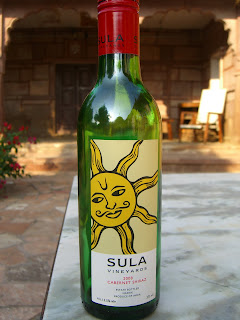
Indian wine? Really?
Yes, yes, we all know that India is a country rapidly on the move, rich in intellectual capital, a world-class producer of pharmaceuticals, steel, IT services, aerospace technology, high-end skills. It also boasts a fantastic culinary tradition and just about every climatic variation known to man. But wine?
Well, put down those raised eyebrows and pay attention. Wine has been made in India for centuries, and the new Indian wine industry is actually nothing more than a resurgence of a well-established tradition. The biggest concentration of vineyards is not far from Mumbai; with a couple of smaller regions near Shimla (north) and Bangalore (south). Wine exports from India are increasing at an annual rate of around 9 per cent, while domestic consumption, fuelled by the growth of the new Indian middle class, is similarly on the rise. And the reason why I'm going on about Indian wine so flagrantly is because I've just got back from that country, and yes, it is fantastically exciting, eye-opening, dazzling, bonkers, all the platitudes. And I drank a bit of wine while I was out there.
Not a huge amount, because they were charging London prices, the equivalent of £20 a bottle if you're rash enough (I know I was) to ask for it in your boutique hotel. Nor could I find any cheaper wine at any of the numerous so-called Wine Shops we passed along the way, because the numerous Wine Shops seemed to sell only beers and spirits of a faintly intimidating nature, not wine, not the ones I went into.
The other restriction concerned the brand: because wherever you do see wine on offer, chances are it'll be from the Sula Vineyard, which seems to have colonised the territory fairly thoroughly, with its amiable branding (a smiley sun god, Surya, welcoming you to the label); serious investment in production and quality control (including India's first tasting room, designed by Californian architects, even); and entrepreneurial zip (the founder, Rajeev Samant, was a Silicon Valley wiseguy before getting stuck into the wine revolution). Sula now offers a range of over twenty different wines, reds, rosés, whites and sparkling, also no aversion to screwtops, a completely modern take on things, and a similarly modern desire to have the marketplace to themselves.
The pity of it is that I only seem to have drunk a half-bottle of the Cabernet Shiraz (maybe that's all they had) while staying in my 17th-Century Rajasthan gentleman's micropalace. False memory told me it was a whole bottle until I looked at the picture on my return home. Because, according to some notes I made in haste immediately after swigging it, it was pretty good. Rather daringly, I observed that it was low on tannin, but big and blackcurranty, and, conveniently cribbing from the notes on the back of the bottle, peppery. I also detected a round finish. Overall it reminded me of a thunderous and highly-prized Sicilian red that I tried at the Wine Show last year, the sort of wine whose arm around the shoulder seems to be about to turn into a headlock, but in a good way.
The label also suggested serving it chilled. Given that it was such a hairy-chested wine, not some effete Beaujolais production, this seemed perverse. I'm aware that the convention about room temperature reds can be overdone but I'm not absolutely persuaded that something so big, fruity and enveloping gains a lot from having the bottle lightly misted. On the other hand, given the temperature in much of India, much of the year (Indian joke: Dinner-party hostess to guests – 'Do come and sit down before the soup gets warm'), it may just be a precaution against the stuff mulling itself in the ambient heat.
At any rate I rather wish I'd had the other half, now, hot or cold, and hang the expense. Holiday nostalgia does that to you.
CJ
Some Emotion can’t stay Bottled
ReplyDeleteIndian Wines
Vineyards of India